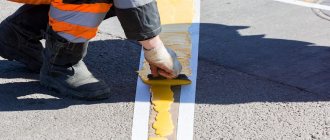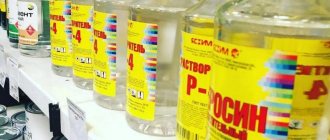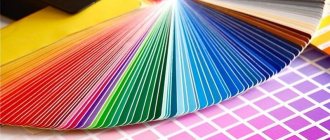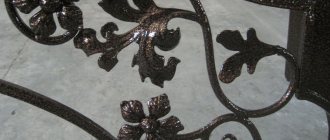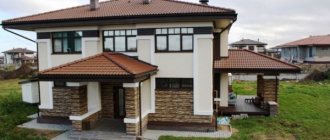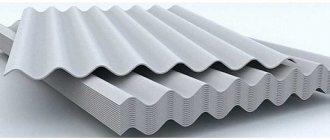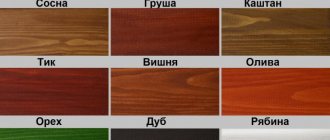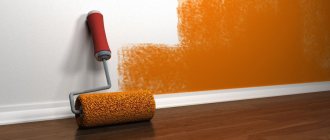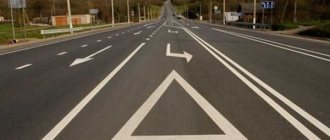Marking increases the capacity of the road and also contributes to maximum safety of its operation.
In order for the specialized marking to perform its functions for a long time, special paint is used for its application. The choice of a specific option depends on various factors, including the condition of the road surface and climatic conditions in a particular region.
Why do you need luminous markings?
Not every road today has luminous markings. Typically this solution is used on the busiest highways.
The advantages of this markup:
- Increased safety - special paint reflects the light of headlights, thereby minimizing the risk of accidents. Drivers can also see road signs in advance in low-light conditions at night.
- Easier navigation on the road at any time of the day.
Varieties
Today there are quite a lot of dyes that are used for marking. They differ in shades and technical parameters.
By color
The key parameter when choosing a marking shade is its contrast with the road surface. In this case, white and yellow shades are usually used. These are the colors that are considered to be the most contrasting to the dark coating.
By gloss level
Lines are often marked with fluorescent and luminous enamels. Reflective paints are special suspensions that include phosphor-type pigments, functional components, acrylic resin solutions, and fillers. Such materials are used for marking roadways, airfields and other coatings based on cement and asphalt-bitumen compositions.
By properties
The material used for application to the road must reflect headlight light well. In this case, dyes are divided into several categories:
- Specialized paints that are often used. They are characterized by a high degree of durability. Most often, paints and thermoplastics are used to mark road marking lines.
- Paints that are used in certain situations. This group includes metal buttons, ceramic or clinker paving stones, porcelain chips, and concrete.
See also
Purpose and top 4 types of waterproof paints, pros and cons of use
The quality of markings is also influenced by the technology of using dye. The lines are applied using the cold or hot method. Individual substances can only be used in a specific method.
The cold method ensures coating durability for up to 2 years.
Expert opinion
Zakharova Irina Yurievna
Cleaning professional with 15 years of experience. Our best expert.
Ask a Question
The hot method of applying the substance is used on roads that require high speed limits. These include highways and highways.
Basic requirements for the paints used
Specialists apply road markings in the warm season in accordance with GOST R51256. In addition to reflecting light, the paints used must have certain characteristics:
- minimal material consumption;
- resistance to temperature fluctuations;
- resistance to mechanical damage and operational wear;
- quick drying (in most cases, at an air temperature of about +20°C, the paint hardens within 5 minutes);
- resistance to moisture;
- ease of application (usually a spray gun and a special stencil are used, which significantly speeds up the process and contributes to the economical consumption of paint with reflective properties);
- ensuring good adhesion of car tires to the road surface.
It is necessary that the paint used has a bright color, so that it can be seen without any difficulty even in the dark and in adverse weather conditions.
What qualities should marking paint have?
The question of the properties of dyes for road markings is divided into two points: the properties of paintwork materials for markings (they are studied by road service workers) and the properties of the marking coating (indicators of interest to marking users - drivers and pedestrians).
DRSU specialists are interested in CM:
- Viscosity. Materials with an index of up to 120c are in demand. The dye is applied manually (with a brush, roller) or diluted to the desired consistency using special equipment.
- Drying speed. The faster the material dries, the greater the productivity of painting work, the less congestion and traffic stops on the highway. Paintwork materials based on acrylic copolymers dry in 15 minutes.
- Pigment particle size in CM or degree of grinding. A dye with a high index clogs the filters of the marking machine faster. The grinding standard is 50-70 microns. If the work is carried out with a roller or brush, then they do not look at the number.
- The volume of CM that goes into covering a unit area of an asphalt road is an indicator of covering capacity. A higher hiding power figure means an increase in CM consumption. Considering that the density of road paint is 1.4-1.6 g/m3, “heavy” dyes will have high hiding power. For example, marking material KM AK-511 has a covering capacity of up to 200 g/m2, and enameled material PF-115 has a covering capacity of up to 100 g/m2.
- The property “storage stability” is not standardized by GOST. Since road marking paint is purchased by the road service in large quantities and is consumed gradually over 12 months, it is important that the material maintains its quality throughout the storage period. The absence of solid sediment indicates the quality of the CM for marking on asphalt.
- Absence of debris particles or contamination of the material. The presence of debris in the composition leads to rapid clogging of the filters of marking equipment. Their cost is high. Labor costs for filtering the dye and cleaning these filters increase.
Interesting video on the topic:
“Consumers” of road markings (drivers and pedestrians) are interested in the properties of the final coating:
- The marking has a brightness coefficient and color coordinates. Adding SMS to the composition helps improve the visibility of paint on asphalt at night and in bad weather.
- Wear resistance. The indicator is proportional to the hardness of the coating, which depends on the type of film former. For example, acrylic is characterized by high hardness and wear resistance. The strength added to the SMS composition is enhanced. They reinforce the marked coating.
- Resistance to atmospheric factors (UV rays of the sun, precipitation, temperature fluctuations). Road dye should not disappear from the asphalt in the spring when the snow melts. Markings applied with high-quality material retain their quality for at least 6 months. The level of resistance depends on the adhesion of CM and asphalt, on the type of film former, on the proportion of pigments in the composition, on the correctness of marking. Even super-high-quality road paint will not adhere to an unprepared surface and will bounce off if there is dust left or the asphalt is wet.
Acrylic
Manufacturers produce acrylic-based compositions in the form of a concentrate, so before use they must be diluted with water in order to achieve a suitable thickness. These paints are easy to use and can also be sold ready-to-use in aerosol form.
Acrylic paints can be applied using different methods, but aerosol spraying is usually used. Such compositions can be applied not only to asphalt, but also to concrete and oil-bitumen coating.
It is recommended to use water-dispersion paints in warm weather, provided there is no precipitation, since contact with water after application usually leads to the paint being simply washed off the road surface.
The drying time for polyacrylic paint is about 30 minutes.
Features of choosing enamel for marking
The composition of the paint and varnish material for marking will determine the conditions of its use.
- Climatic features of the region.
- Traffic intensity. On highways, wear-resistant materials are needed for marking. Two-component formulations are suitable.
- physico-chemical features of asphalt pavement.
Acrylic
Acrylic paint is available in a concentrated state, so it must be diluted with water to the desired thickness. It is easy to use and can be sold ready-made, in aerosol form.
Acrylic-based paints can be applied using any method, often using aerosol spraying. Such compositions can be applied not only to asphalt, but also to oil-bitumen and concrete road surfaces.
It is necessary to work with water-dispersed compounds in warm and dry weather, since if it gets wet immediately after application, the dye can be washed off from the road surface.
The polyacrylic mixture hardens half an hour after painting.
Alkyd
Alkyd dyes have a rubber base. They appeared relatively recently. They have high adhesive properties and increased wear resistance. They perform well on high-speed highways. Consumption per 1 m2 may vary for different types of coatings. This paint cannot be applied using the aerosol method.
Other enamels, in which reflective powder is mixed, can be used on less busy roads and where road markings have already been painted.
Use on busy roads is not recommended, since the distribution of luminous particles in them is uneven.
Two-component
These are innovative enamels. Their production is carried out using modern technologies. The composition does not include a solvent, and the concentration of reflective pigment is much higher than that of other compositions.
Such paints have high strength and adhesive characteristics. The applied markings are not damaged even by snow removal equipment. Two-component enamels can be used on any type of coating.
To apply them, you can use both classic aerosols and complex special drawing equipment. The mixture consumption does not exceed 0.5 kg per m2. Airfield markings can be applied.
Alkyd
Alkyd paint compositions are based on a rubber component. Such paints entered the market relatively recently; they are characterized by good adhesion and a long service life. Dyes of this type are well suited for highways. Material consumption per 1 m2 depends on the characteristics of the coating. Alkyd paints are not applied by aerosol.
Other enamels, which contain powder with reflective properties, can be used on roads with low traffic volumes and where appropriate markings have already been applied.
It is not advisable to use it on busy roads, since the luminous elements are usually unevenly distributed over the surface.
Composition of marking paint
CMs for marking differ from each other in composition, which determines the method of their application and affects the shelf life of technological characteristics. Marking paint contains:
- on average 4-6 constituent components;
- color-substance;
- fillers;
- plasticizers;
- polymer elements;
- additives;
- special solvents.
Individually, each element in the composition performs its function. But increasing the stability of the marking and its service life depends on the polymer binder.
The paint for road markings complies with the European standard regarding “Environmental requirements”. So the remaining dry matter of the CM is no less than 75%. Adhering to the same requirements, the release of solvents and volatile organic substances into the atmosphere is maintained. Such restrictions do not affect the quality of the dye.
Useful video on the topic:
Two-component
Such paints are one of the most modern developments. The enamel contains no solvent, and the content of the reflective component is higher compared to other compositions.
Paints in this category are characterized by high adhesion and durability. Even snowblowers are unable to damage the markings applied with such a composition. Two-component compounds can be used on various types of road surfaces.
Paint can be applied using traditional aerosols or using specialized painting equipment. For every 1 m2 of coating, no more than 500 g of composition is consumed. Can be used for marking at airfields.
Application method
Road markings can be applied using two technologies. The choice of methodology is carried out taking into account the state of aggregation of the composition used.
Cold option. This technique is used when applying markings with water-dispersed paints, as well as compositions based on cold plastics and natural solvents. The technology is used for marking on surfaces that are subject to heavy wear, for example, pedestrian crossings fall into this category. The marking lasts about 24 months. At maximum traffic intensity, hot technology is used.
The hot method is used when working with thermoplastics and special yellow tapes, which are attached to the road surface using adhesive and a gas torch. To successfully complete the work, the air temperature must be in the range from +5 to +35°C.
The nuances of using road material
There are three rules that will help when working with road dye:
- CM that has been stored for a long time is thoroughly mixed before use. Filtration is carried out so that pieces of dense sediment do not clog the filters of marking equipment.
- Manufacturers use 60 kg drums and 30 kg buckets for packaging. Drums are purchased for applying markings using machinery, and buckets for manual application.
- Road paint is quick drying. If a large layer is applied, the marking will dry on top, and there will be soft paintwork inside. As a result, the markings will be trampled by cars.
Enamel “AK-511” (road paint)
This composition is used for marking roadways and streets in temperate continental climates. The material contains various fillers, dyes and modifying components. The paint meets the requirements of GOST R52575-2006, which regulates the use of the material for use on public roads.
“AK-511” dries quickly, has high light resistance and good brightness, making the markings visible in different lighting conditions. The enamel is resistant to wear, chemicals and moisture, and also has high adhesive properties.
To achieve the maximum reflective effect, special glass beads can be added to the AK-511. The material is applied to a previously prepared, dry and clean coating. A thinner may be used. In order for the marking to better reflect light, a special composition is additionally applied over the marking. This solution has many advantages:
- compliance with the requirements of GOST R52575-2006;
- efficiency of application;
- increased resistance to the negative effects of external factors;
- improving the functional characteristics of markings.
If you apply paint in a layer 2.5 mm thick, each “square” takes from 3.5 to 4 kg of material.
basic information
Road markings can be permanent or temporary. The first is most often applied with white paint, and the second with red or orange. The main requirement for color is contrast with the shade of the asphalt or concrete road surface.
There is the following classification of markings:
- Longitudinal. Such markings can be found on almost any part of the route. It denotes the boundaries of traffic lanes or the routing of cars on different sides. A solid line outlines the roadway and crossing it is prohibited. As for the dotted line, it performs almost the same tasks, but you can cross such a line. But a double solid strip is used to separate traffic flows moving in different directions.
- Transverse. These markings are intended primarily for pedestrians. It is applied perpendicular to the flow of traffic. For drivers, such markings serve as a signal to slow down or stop. One of the types of cross markings is a pedestrian crossing, which is called a “zebra”. An important role is also played by the line indicating the stopping place to wait for a particular traffic light signal.
- Arrows. They indicate the direction of movement of passers-by or cars. Sometimes they are double or triple (they can point in different directions), which indicates the possibility of choosing the route to follow.
- Pictograms. These include images of wheelchair users or bicycles.
In the program for studying traffic rules, much attention is paid to markings. If you would like to purchase high-quality anti-slip road surfaces, please contact our company.
An unfamiliar color of road markings can confuse the driver, which is why all its varieties and shades are strictly regulated. Markings on asphalt and vertical surfaces provide traffic participants with important information and allow or prohibit certain maneuvers. Typically, road marking paint is used in white, black, yellow and orange.
Paint "TechnoNIKOL AK"
This enamel belongs to the segment of one-component materials, the application of which is possible using cold technology. The material is based on highly dispersed dyes and fillers.
TechnoNIKOL AK enamel does not need to be diluted beforehand; it is supplied ready for use. Can be used for applying horizontal markings on roads with concrete and asphalt concrete surfaces. There are different versions of the material on sale, each of which has a specific purpose - federal highways, interregional and regional highways, other roads, sidewalks and parking lots. Enamel consumption depends on the chosen modification and coating characteristics. The average is 400-700 g per 1 m2.
Rating of popular brands
The most popular substances that are often used for road markings include the following:
- TechnoNIKOL AK. This product is a one-component substance that must be applied cold. It is based on high-quality pigments and fillers. The dye does not require the use of solvents - it is ready for use. The composition is suitable for drawing horizontal lines on the road. It can be used for asphalt or concrete pavement.
- Indecoat-511. This material is used quite often. Essentially, it is a combination of pigments, additives and fillers. The composition can be used in a wide temperature range, which ranges from -40 to +60 degrees. The material is characterized by high wear resistance and whiteness. It can be applied to concrete and cement surfaces.
- Enamel AS-5307 “Line”. This dye is often used to apply safety lines. It can be used for concrete and asphalt pavement. Contains reflective beads. With their help, it is possible to achieve the glow of the markings. Brightness settings reach 80%.
Enamel "Line"
The paint is suitable for marking safety lines on roads with asphalt or concrete surfaces. The enamel contains reflective beads, due to which its brightness is 80%. White, red, yellow and black paint is available for sale, which is suitable for marking on public roads and airfields. Key features of the “Line” composition:
- possibility of use on roads for various purposes;
- possibility of application using different methods, including specialized installations, aerosol cans and pneumatic equipment;
- quick drying;
- increased brightness makes markings visible even in foggy conditions;
- good adhesion;
- the possibility of using pigments to apply markings of different colors in small areas;
- the ability to store material in a wide temperature range;
- no problems with burnout, resistance to external factors.
Line enamel differs from analogues in its long service life and affordable cost.
Shades for comfort and safety
To ensure that the driver can be guided by the markings regardless of what country he is in, all countries use white for permanent road markings. It divides the roadway into lanes and also marks the side boundaries of the roadway. In addition, standards often allow permanent markings with yellow paint (in Russia, this is how public transport and taxi stops and sections of the road where stopping is prohibited are indicated). You can also see solid yellow stripes on regional and federal highways. They serve to attract the attention of drivers on particularly difficult sections. The reflective effect of the stripes is often given by micro glass beads, which are added to the base paint.
The orange color of the markings indicates the temporary nature of the changes made on this section of the route. Typically, such markings are applied to the road surface during repair work. It prohibits overtaking, pulling onto the side of the road, and indicates the direction of travel. Temporary orange stripes quickly disappear on their own after repairs are completed, or are removed from the asphalt surface by a team of road workers. Markings are often black: dark stripes are applied to poles, railings, concrete fencing blocks and other objects in order to increase visibility.
From June 1, 2022, another marking appeared on Russian roads. Blue color will indicate elements that will help you navigate at intersections and parking lots. Lines will appear as the old markings wear away.
The safety of all road users, as well as the speed of traffic flow, largely depends on the quality of markings. Poorly visible lines on the highway can lead to accidents. To avoid this, when marking, it is necessary to use high-quality cold plastic for road markings, thermoplastic for road markings, or specialized paint and varnish compositions.
Indecoat-511
The composition of Indecoat-511 material includes dyes, additives and fillers. Markings applied with this paint cope with their tasks in a wide temperature range - from -40°C to +60°C.
In the manufacture of the composition, foreign-made materials and the latest technological developments are used. Thanks to this, the material is resistant to wear and is particularly white. Marking can be applied to asphalt concrete and cement concrete.
The basic version is presented in white, but the manufacturer also offers red, orange and black colors. When applying markings in one layer, the material consumption for each “square” of the surface is 300-400 g. Application can be done manually using a roller or using specialized equipment.
To ensure maximum light reflection, special components are added to the paint.
Precautionary Methods
When using dyes, it is important to take precautions:
- The dye must not be opened or applied near fire sources or flammable liquids.
- All work must be performed using protective equipment. To do this, you need to wear a special suit, glasses, gloves, and a respirator.
- If paint gets on your skin, rinse it immediately with water.
- Do not use water, kerosene or gasoline to thin paints or wash tools.
Cold plastic
Modern technologies make it possible to use not only special coloring compounds, but also cold plastic for marking. This material is more resistant to wear and has an impressive service life even under extreme conditions. Stripes and signs have a shelf life of 24 months, but plastic has a much longer shelf life. Russian companies produce cold plastic from foreign raw materials. Thanks to this, high quality is maintained, but at the same time the cost of the material is more affordable compared to imported analogues. The thickness of the layer when applying the material is 2 mm, and its consumption per 1 m2 is 3.5-4 kg.
Road markings in Russia
Thus, money is saved. And this is a very important indicator, especially if the use of paint and varnish products takes place in government affairs, because expenses are covered by allocations from the budget.
There is an expression in Russia that the two main problems that everyone and everywhere encounter are fools and roads. Let's focus on the latter. The condition of the road surface along its entire length leaves much to be desired. There are, of course, individual sections of tracks that meet all the established indicators and do not cause any complaints. But overall the situation is not very good.
This is due to the presence of potholes, uneven surfaces, and incorrect or missing lane markings in some places that motorists should follow. This leads to frequent accidents involving pedestrians, drivers of cars and trucks. The result is harm to the health and lives of people (mild, moderate, severe), causing material damage to the property of owners, blocking traffic flow and many other negative consequences.
One way to partially solve the existing problem regarding markings would be to use high-quality materials from the paint and varnish industry to apply identification elements to the asphalt surface. This is made possible by the creation of tools whose purpose is to exclusively perform this task.
Now let’s take a closer look at each of the questions: about the marking of the road surface, the paintwork materials for its application (characteristics of each type separately), the ways in which this process can be carried out, technical support, conditions that change the state of the paint present on the asphalt surface.
"Track"
The material is quite durable and wear-resistant, and can be used at airfields and busy highways.
The main advantages of paint for marking “Pathway”:
- possibility of application by machine and manually;
- wear resistance;
- UV resistance;
- minimum consumption;
- high strength;
- maintaining original characteristics even under severe mechanical stress, including contact with snow removal machines;
- resistance to chemicals used to combat ice;
- acceptable cost.
To ensure maximum marking service life, it is necessary to select the material taking into account individual requirements and take into account the characteristics and operating conditions of the specific paint.
Hot type of application of materials
In some aspects, this method is more effective than the previous one.
Its advantages include:
- Extended service life of hot-applied coatings. This is due to a noticeable thickening of the layer of material used for marking.
- Less time-consuming production thanks to a fully mechanized process.
But there are also quite noticeable weaknesses, one might even say difficulties. First of all, it is a question of price. Hot production is several times more expensive than cold production. Secondly, constant monitoring of the temperature regime in automobile containers with paints and varnishes is necessary. Thirdly, you need special equipment that is designed specifically for this.
It’s easy to guess that the main material intended for this type of application is thermoplastic (“thermo” means heat, heat).
An example of this type of product is thermoplastics:
- "Megoplast"
- "Technoplast"
- TPK,
- TPK-N,
- texture M-1, M-2.
